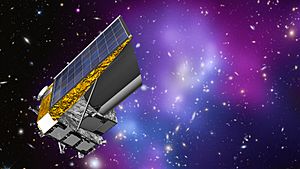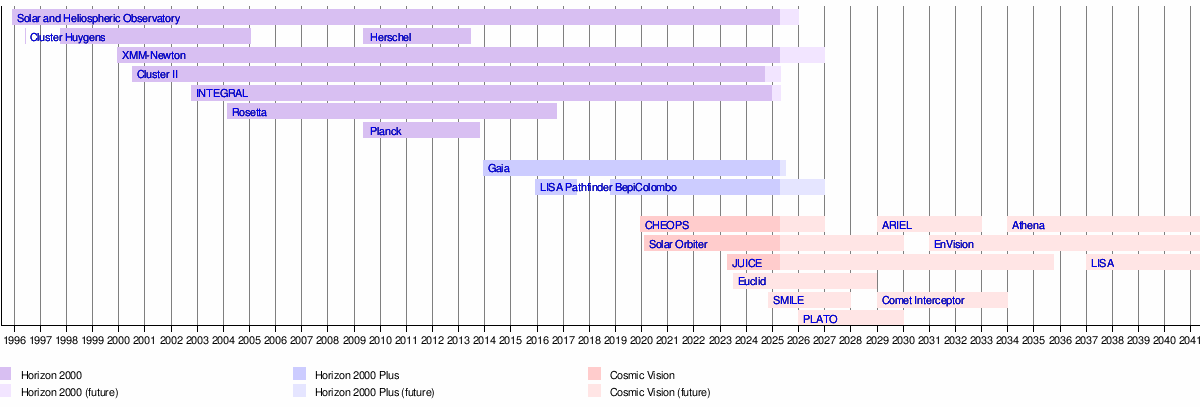European Space Agency Science Programme facts for kids
The Science Programme of the European Space Agency is a long-term programme of space science and space exploration missions. Managed by the agency's Directorate of Science, The programme funds the development, launch, and operation of missions led by European space agencies and institutions through generational campaigns. Horizon 2000, the programme's first campaign, facilitated the development of eight missions between 1985 and 1995 including four "cornerstone missions" – SOHO and Cluster II, XMM-Newton, Rosetta, and Herschel. Horizon 2000 Plus, the programme's second campaign, facilitated the development of Gaia, LISA Pathfinder, and BepiColombo between 1995 and 2005. The programme's current campaign since 2005, Cosmic Vision, has so far funded the development of ten missions including three flagship missions, JUICE, Athena, and LISA. The programme's upcoming fourth campaign, Voyage 2050, is currently being drafted. Collaboration with agencies and institutions outside of Europe occasionally occur in the Science Programme, including a collaboration with NASA on Cassini–Huygens and the CNSA on SMILE.
Contents
Cosmic Vision
Cosmic Vision 2015–2025 is the current programme of ESA's long-term planning for space science missions. The initial call of ideas and concepts was launched in 2004 with a subsequent workshop held in Paris to define more fully the themes of the Cosmic Vision under the broader subjects of astronomy and astrophysics, Solar System exploration and fundamental physics. By early 2006 the formulation for a 10-year plan based around 4 key questions emerged:
- What are the conditions for planet formation and the emergence of life?
- How does the Solar System work?
- What are the fundamental physical laws of the Universe?
- How did the Universe originate and what is it made of?
In March 2007 a call for mission ideas was formally released, which yielded 19 astrophysics, 12 fundamental physics and 19 Solar System mission proposals.
Large class
Large class (L-class) missions were originally intended to be carried out in collaboration with other partners with an ESA-specific cost not exceeding 900 million euros. However, in April 2011 it became clear that budget pressures in the US meant that an expected collaboration with NASA on the L1 mission would not be practical. The down-selection was therefore delayed and the missions re-scoped on the assumption of ESA leadership with some limited international participation. Three L-class missions have been selected under Cosmic Vision: JUICE, a Jupiter and Ganymede orbiter planned for launch in 2023; Athena, an X-ray observatory planned for launch in 2034; and LISA, a space-based gravitational-wave observatory planned for launch in 2037.
Medium class

Medium class (M-class) projects are relatively stand-alone projects and have a price cap of approximately 500 million euros. The first two M-class missions, the Solar Orbiter heliophysics mission to make close-up observations of the Sun, and the Euclid visible to near-infrared space telescope, aimed at studying dark energy and dark matter, were selected in October 2011. PLATO, a mission to search for exoplanets and measure stellar oscillations, was selected on 19 February 2014, against EChO, LOFT, MarcoPolo-R and STE-QUEST After a preliminary culling of proposals for the fourth M-class mission in March 2015, a short list of three mission proposals selected for further study was announced on 4 June 2015. The shortlist included the THOR plasma observatory and the XIPE X-ray observatory. ARIEL, a space observatory which will observe transits of nearby exoplanets to determine their chemical composition and physical conditions, was ultimately selected on 20 March 2018. The competition for the fifth M-class mission concluded in June 2021, with the EnVision Venus orbiter ultimately being selected for launch in 2031. The SPICA far-infrared observatory and THESEUS gamma-ray observatory were the other two proposals.
Small class
Small class missions (S-class) are intended to have a cost to ESA not exceeding 50 million euros. A first call for mission proposals was issued in March 2012; the winning proposal would need to be ready for launch by 2017. Approximately 70 letters of Intent were received. CHEOPS, a mission to search for exoplanets by photometry, was selected as the first S-class mission in October 2012 and will launch in Fall 2019. SMILE, a joint mission between ESA and the Chinese Academy of Sciences to study the interaction between Earth's magnetosphere and the solar wind, was selected as the second S-class mission from thirteen competing proposals in June 2015. As of April 2021, SMILE is scheduled for launch in November 2024.
Fast class
At the ESA Science Programme Committee (SPC) Workshop on 16 May 2018, the creation of a series of special opportunity Fast class (F-class) missions was proposed. These F-class missions will be jointly launched alongside each M-class mission starting from M4, and would focus on "innovative implementation" in order to broaden the range of scientific topics covered by the mission. The inclusion of F-class missions into the Cosmic Vision program will require an increase of the science budget. F-class missions must take under a decade from selection to launch and weigh less than 1,000 kg. The first F-class mission, Comet Interceptor, was selected in June 2019. On November 2, 2022, ESA announced the F-class mission ARRAKIHS.
Missions of Opportunity
Occasionally ESA makes contributions to space missions led by another space agency. Missions of opportunity allow the ESA science community to participate in partner-led missions at relatively low cost. The cost of a mission of opportunity is capped at €50 million. ESA missions of opportunity include contributions to Hinode, IRIS, MICROSCOPE, PROBA-3, XRISM, ExoMars, Einstein Probe, and MMX. A contribution to SPICA (Space Infrared Telescope for Cosmology and Astrophysics), a Japanese JAXA mission, was evaluated as a mission of opportunity within Cosmic Vision. It is no longer considered within that framework, though SPICA is now one of the mission proposals being considered for M5.
Voyage 2050
The next campaign of the ESA science programme is Voyage 2050, which will cover space science missions operating from 2035 to 2050. Planning began with the appointment of a Senior Committee in December 2018 and a call for white papers in March 2019.
Three Large class and six to seven Medium class missions are currently anticipated in this plan, as well as smaller missions and missions of opportunity. On 11 June 2021, the Senior Committee published the Voyage 2050 plan, and recommended the following science themes for the next three Large class missions:
- Moons of the giant planets – a mission to an ocean-bearing gas giant moon.
- From temperate exoplanets to the Milky Way – a mission to either characterize exoplanets or investigate the Milky Way's formation history.
- New physical probes of the early Universe – a mission to investigate the early universe through the cosmic microwave background, gravitational waves, or other fundamental astrophysical phenomena.
Timeline

See also
- List of European Space Agency programs and missions
- List of Solar System probes
- List of space telescopes
- Living Planet Programme





